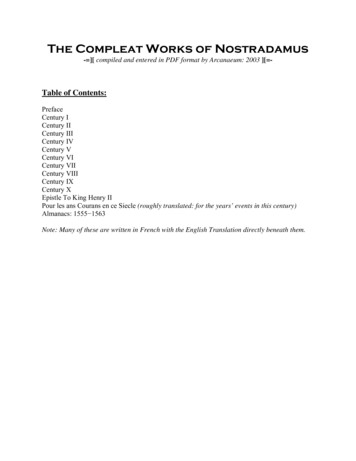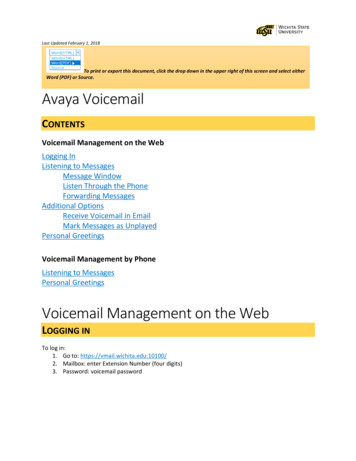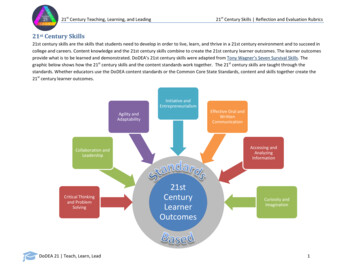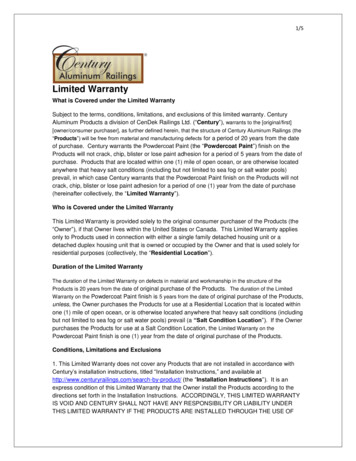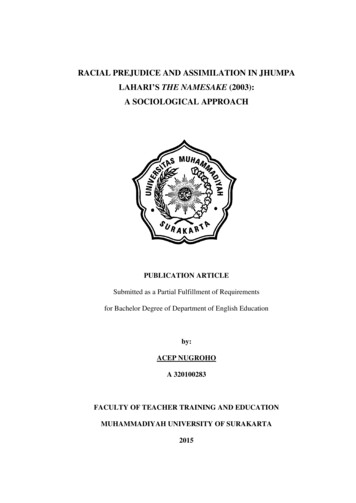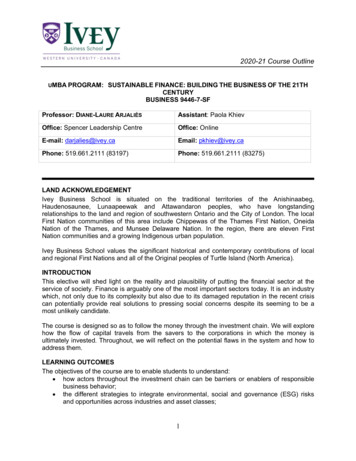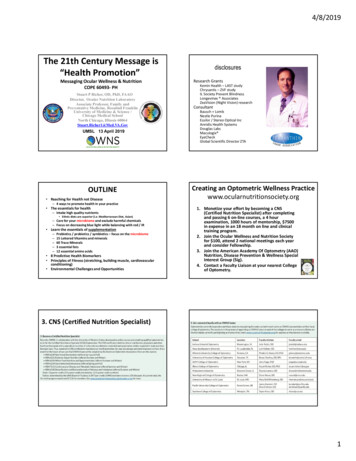
Transcription
4/8/2019The 21th Century Message is“Health Promotion”Messaging Ocular Wellness & NutritionCOPE 60493‐ PHStuart P Richer, OD, PhD, FAAODirector, Ocular Nutrition LaboratoryAssociate Professor, Family andPreventative Medicine, Rosalind FranklinUniversity of Medicine & Science /Chicago Medical SchoolNorth Chicago, Illinois 60064Stuart.Richer1@Med.VA.GovUMSL 13 April 2019OUTLINE Reaching for Health not DiseaseDisclosuredisclosuresResearch GrantsKemin Health – LAST studyChrysantis – ZVF studyIL Society Prevent BlindnessLongevinex AssociatesZeaVision (Night Vision) researchConsultantBausch LombNestle PurinaEssilor / Stereo Optical IncAnnidis Health SystemsDouglas LabsMaculogix EyeCheckGlobal Scientific Director ZTACreating an Optometric Wellness Practicewww.ocularnutritionsociety.org– 4 ways to promote health in your practice The essentials for health– Intake high quality nutrients Ethnic diets are superior (i.e. Mediterranean Diet, Asian)– Care for your microbiome and exclude harmful chemicals– Focus on decreasing blue light while balancing with red / IR Learn the essentials of supplementation–––––Prebiotics / probiotics / symbiotics – focus on the microbiome15 Lettered Vitamins and minerals60 Trace Minerals3 essential fats12 essential amino acids 8 Predictive Health Biomarkers Principles of Fitness (stretching, building muscle, cardiovascularconditioning) Environmental Challenges and Opportunities1. Monetize your effort by becoming a CNS(Certified Nutrition Specialist) after completingand passing 6 on‐line courses, a 4 hourexamination, 1000 hours of mentorship, 7500in expense in an 18 month on line and clinicaltraining program.2. Join the Ocular Wellness and Nutrition Societyfor 100, attend 2 national meetings each yearand consider Fellowship.3. Join the American Academy Of Optometry (AAO)Nutrition, Disease Prevention & Wellness SpecialInterest Group (Sig).4. Contact a Faculty Liaison at your nearest Collegeof Optometry.3. CNS (Certified Nutrition Specialist)1
4/8/201936 Page PDF: A RO‐OWNS SUPPLEMENT15 September 2018Distribution of home care clients with hearing and vision sensoryand/or cognitive impairments.ImpairedSmell -3xgreater riskUPSITNEWDATA2018Guthrie DM, Davidson JGS, Williams N, Campos J, Hunter K, et al. (2018) Combined impairments in vision, hearing and cognitionare associated with greater levels of functional and communication difficulties than cognitive impairment alone: Analysis of interRAIdata for home care and long-term care recipients in Ontario. PLOS ONE 13(2): 971http://journals.plos.org/plosone/article?id 10.1371/journal.pone.01929715 Key Insights1. 92% of health is determined from the interaction of theenvironment with DNA (The Science of Epigenetics).2. Promotion of traditional whole natural plant and farmfood and minimization of industrial chemicals,additives, natural and artificial sweeteners, hormonedisruptors and other 21st century health challenges andusing natural light are at the heart of preventativemedicine strategies.3. Understanding the 8 predictive biomarkers for health,and how judicious use of supplementation can help ourpatients achieve better health outcomes is key.4. Stress reduction has quantifiable biologic effects.5. Physical Activity, Fitness & Prayer (manifestation) count.“Primacy” of DNA now questioned(also 99% of our genes are actually in our micobiome)Also called “GeneticDeterminacy”Genes dictate who we areand what diseases wewill inherit.* DNA can be altered orchanged via epigeneticmodification3 mechanisms to change DNA Histones (within Chromatin) DNA methylation miRNANew York Times 2008122
4/8/2019Counter 21st CenturyThreats to our Microbiome1. Lectins (Gluten, WGA)2. Soy products3. Broad‐spectrum antibiotics4. Chronic NSAIDs5. Chronic GI acid blocker use6. Artificial sweeteners,and food additives7. Environmental Hormonedisruptors8. Herbicides, biocides, fertilizers9. GMOs10.NitratesSTART WITH QUALITY RAW MATERIALS( especially before pregnancy ) 15 lettered vitamins 60 trace minerals 12 essential amino acids 3 essential fats90 componentsNUTRITIONAL GENIUSYour DNA ResultsYour Food Sensitivity ResultsIntegratedReportShopping ListNutraceutical Care PlanEPI -GENETICSGENETICSEPIGENETICSMutationsGene protein making(gene expression or silencing)change in sequenceInheritedMethylation Histone modifcations microRNAImprintingSome chromosomes or some genes are stamped with a‘memory’ of the parent from whom it came.PolymorphismsVariability, adaptability, regenerationExample: blood type The gene variant, short description and testresult are included183
4/8/2019Why is all of this 23 and Me and YouStuff important ? Patient’s that are not getting better even though they have balanced theirhormones, thyroid, look at their www.23andme.com; methylation profile, copper,zinc, pyrolles etc. – useful information If patient’s want to get off antidepressants‐ useful information If you are working with a younger person‐ early 20 or teens that has anxiety,depression, PMS, ADD, ADHD and eye diseases etc – useful information If your patient has a family history of depression or anxiety and now they want toget pregnant. You want them to know their biochemistry‐ so they can correct it, soas not to pass that gene expression to their kids – useful information If your patient is very intense, and concerned about staying on top of their game.Check their brain chemistry. By replacing the nutrients, correcting the deficienciesthey can get their brain healthy, prevent aging, and disease‐ useful informationwww.23andMe.com(10 new high value tests pending release ) HereditaryHemochromatosis Celiac Disease AMD (Y402H &A69S) Late Onset AD Parkinson’s Disease Alpha 1 AntitrypsinDeficiency HereditaryThrombophiliaRefined sugars, grains, vegetable oils and dairy 70.9% of energy of the U.S. food supplyMeats,Fish1.4 Eggs15.718.6RefinedVegetableOilsNuts, Seeds3.1 LegumesRefinedSugars3.3 FruitsDairyGrains4.8 Vegetables17.80.8 Miscellaneous23.9 10.6Refined sugars, grains, vegetable oils and dairyrepresent Neolithic & Industrial era foods that werenot present in traditional ancestral human dietsBy default, their inclusion displaces minimallyprocessed, wild plant and animal foods.Gerrior S, Bente I. 2002. Nutrient Content of the U.S. Food Supply, 1909-99: A Summary Report.U.S.D.A, Center for Nutrition Policy and Promotion. Home Economics Research Report No. 55We Used To Have 307 Kinds Of Corn.Guess How Many Are Left?National Geographic charts our dwindling food variety.% US population with INADEQUATEintake of the RDA100.00%90.00%CORN monocultureWHEAT monoculture70.00%60.00%UndesirableLectins ‐ plant proteinsGluten – large moleculeWGA –Wheat Germ Agglutinin‐ small molecule‐ insulin mimicryincreases fatmuscle & brain cells starvefor energy (sarcopenia &AD)LPS %57.00%54.00%42.00% 40.30%40.00%30.00%20.00%10.00%29.20%26.10%20.30% 18.40%15.80%12.80% 10.90%10.50% 8.50%0.00%4
4/8/2019Nutrient depleting drugsStatins ‐ CoenzymeQ10, selenium, vitamin D,Antacids ‐ B vitamins, vitamin C, vitamin D,carotenoids, MG , ZN Diuretics ‐B1, B12, magnesium, potassium, Vit. C,Aspirin ‐ folic acid, vitamin C, iron, to name a fewAlcohol ‐ B1, zinc, magnesiumWhich Fast Food Chainhas taken over your state ?Can the“Affordable Care Act”or“Medicare For All”Possibly fix this ?NOColor key: black is McDonald’s, red Burger King, yellow Wendy’s,magenta Jack in The Box, periwinkle Sonic, cream Dairy Queen, greenCarl’s Jr., and cyan Hardee’s. Three colors combine per region; so ifyou see darker colors, it means McDonald's is supreme. Whiter onesBruce Ames, PhD Micronutrient deficiency is indistinguishablefrom radiation damage when examiningcultured cells in a petri dish. Vitamin insufficiency is boosting age‐relateddiseases.Natural Sources of Antioxidants Berries: Blueberries, blackberries, raspberries, strawberries,acai and cranberries Beans: Small red beans and kidney, pinto and black beans Fruits: Many apple varieties (with the peel left on), avocados,cherries, green and red pears, fresh or dried plums,pineapple, oranges and kiwi fruits Vegetables: Artichokes, spinach, red cabbage, red and whitepotatoes (with peel), sweet potatoes and broccoli Beverages: Green tea, coffee, red wine and some fruit juices Nuts: Walnuts, pistachios, pecans, hazelnuts and almonds Dessert: Dark chocolate Grains ?: Whole grain-based products (Cordain / Gundry) no5
4/8/2019OWNS BOARD MEMBERThink Eggs % RDA Vit A 6%; Vit B215%; Vit B5 5%; Vit B95%; Vit B12 9% ,Phosphorous 9%, SE22% and Vit D, E, K, B6,CA and ZN. LOW CALORIE HIGH CHOLESTEROL WLECITHIN RAISES HDL CONTAINS CHOLINE TURNS SMALL DENSE LDLINTO LARGE FLUFFY LDL LUTEIN & ZEAXANTHIN &VIT A LOWERS TGs (pastured) 6 g COMPLETE PROTEIN IN LOW CARB PATIENTS,IMPROVEMENT IN THEIRCARDIAC RISK FACTORS HIGH SATIETY INDEX *Immunoglubulinswww.health.com14 SuperFoods SpinachSardinesTurkey BreastBroccoliWalnutsTomatoSoy Green TeaDaily sunlight and/or 1000 IU vitamin D3(Double for people of color) daily also is veryimportant for general healthGeographic Atrophydry late stage progression disappointingAREDS II intervention dataHIGH POTENCYMULTIVITAMIN,MULTIMINERALSUPPLEMENT3 ESSENTIALFATTY ACIDSPREBIOTICS ,PROBIOTICS,SYMBIOTICS60 TRACEMINERALS12 essential0AminoAcidsAlzheimer's in America(3rd Leading Cause of US Death / Rare in India) 72.8 years average age onset 1 in 10 people over age 65.– 6-8 % develop symptoms before age 65 ( 300,000people).– Few experience symptoms between ages 30 & 40.C1 50 % for Americans over age 85– Multisensory Impairment (Eyes / Ears / Brain)– Few covered by US programs.Photo courtesy of Stuart Richer, OD, PhD– 5.7 million Americans (47 million worldwide)– Projected 14 million Americans by 2050.– Move to India ?6
Slide 35C1need copyright for burning hill photoCynthia, 2/10/2014
4/8/2019 US AD Burden2nd Leading Cause of death in UK 2x the cost of ambulatory care2.5x the cost of hospital care7x nursing home costsBillions in Caregiver ServicesGetting Worse– Costs Double in 20 years– Priceless Emotional Cost to Families 40 % of family care givers pre-decease their dependent familymember Logistically difficult to do AD researchSimilar data for UK females2 common optometric ADIssues encountered1.2.3.4.5.6.7.Learning & Retaining New InformationHandling Complex TasksAbility to Reason - appropriatenessSpatial Ability & Orientation (driving)Chronic Reading Fatigue – can’t read 2 pagesLanguage (speaking & comprehension)Behavior (personality changes, mood)Basic Stimuli requirementfor Cognition Assessment1000 HzSoundThe visual stimulus is a 7.9 degreeBlack Circle presented centrallyagainst a White background with astimulus duration of 100 ms with apseudo-randomized inter-stimulusinterval (ISI) of 2500–3500 ms toprevent anticipation.The auditory stimulus is aa 1000 Hz sinusoidal puretone presented via thebuilt-in speakers of alaptop.June 2018- An international team ofscientists have just developeda new way to screen for agerelated cognitive decline athome using a test which askspeople to detect sounds andflashes on their laptop orphone.PUBLIC DOMAINVitamin A(night vision, hearing, olfactory etc.) 3 human dietary forms: preformed vitamin A (retinol& retinyl ester) and pro‐vitamin A carotenoids (Bcarotene).– All forms of vitamin A solubilized into micelles inthe intestinal lumen and absorbed by duodenalmucosal cells.– Most vitamin A stored in the liver as retinyl esters. In the retina, vitamin A is converted to retinol,oxidized to retinal and then retinoic acid. Included in AREDS/AREDS2 studies7
4/8/2019Beta Carotene Beta carotene is an effective antioxidant But Not an appropriate source of Vitamin A– Does not as readily covert to pre-formed Vitamin A (retinol) in theolder population as it does in younger people– Does not convert to vitamin A if there are sufficient stores of VitaminA in the system. Increased risk of cancer in smokers and SECOND-HAND smokers,when imbalanced with vitamin D3. Interferes with the absorption of lutein /Zx“Higher beta-carotene intake was associated with an increased risk ofAMD.”- Dietary Antioxidants and the Long-term Incidence of AgeRelated Macular Degeneration (The Blue Mountain EyeStudy)Jennifer, SL Tan, et al. Ophthalmology 2008; 115:334-341Vitamin B1 (thiamin)– Severe deficiency Beri Beri (POWs, Alcoholics)– The US diet of refined carbohydrates, sugar,coffee, alcohol, tea and pharmaceuticals depletesour reserves.– Thiamin helps produce the neurotransmitter ACH– Involved in multi‐system diseases and AMD– Thiamin is involved in Alzheimer's’ disease sothese cognitively challenged patients shouldavoid drinking abundant sweetened soda andfruit juices.– Reduces B amyloid protein.– Fat soluble thiamin (benfo‐thiamine) is a valuablesupplement for alcoholic or uncontrolleddiabetics suffering from diabetic neuropathy andmacular edema.Essential B Vitamins – cont . Vitamin B6‐ three pyridoxal enzymes for proteinmetabolism. Biotin – for skin, hair and energy production. Vitamin B9 (food folate)‐ for methylation, DNAsynthesis. Vitamin B12 (i.e methyl cobalamin): supplementationoften resolves symptoms of fatigue and neuritis(tingling, numbness) even when blood levels areadequate, indicating commonly‐occurring bloodconcentration (reference range) is not adequate andtherapeutic doses (above RDA) are required. Lowersthe oxidant homocysteine.8 essential B VitaminsA synergistic combination besti.e. B50 or B100, as reduced by 1) dysbiosis2) age and 3) medications i.e. PPIs Vitamin B1 (thiamin): blood test indicates intakeonly; refined sugars, soda, alcohol, coffee, tea,drugs block absorption. (many many Americansare deficient). Vitamin B2 (riboflavin) cofactor for GSHreductase‐ the major intracellular antioxidant. Aretinal photosensitizer in high doses. Vitamin B3 (niacin) – required by mitochondria Vitamin B5 (pantothenic acid)‐ to synthesize CoAVitamin B3 (niacin)– Comes in multiple forms including “nicotinic acid’that is used clinically to reduce high LDL cholesterol,and niacinamide that supports cellular mitochondria.– Plays a role in converting proteins, fats and carbs intoenergy.– Severe deficiency (pellagra) results in weak muscles,digestive issues and skin irritation.– Niacinamide and riboside‐nicotinamide (along withresveratrol or pterostilbene) support mitochondrialfunction, and are considered all‐ star nutrients forreducing neurodegenerative diseases of aging (i.e.typical Alzheimer’s and Parkinson’s diseases).Vitamin B9 (folate)Folic acid is the synthetic version of food folate.– Natural food folate (found for example in darkgreen leafy vegetables) is the purest leastproblematic form of vitamin B9.– We require this vitamin for methylationreactions and a significant 22% of the USpopulation are ‘under‐methylators’. In this case,high dose supplemental folic acid is sometimesproblematic or even dangerous.– Folate plays a role in the production of DNA,encouraging mutations and the elimination ofnew red blood cells.8
4/8/2019the MTHFR enzymeLow Methylation Promotes Gene Expressionconverts the synthetic B vitamin folic acidto methylfolate ( 85% of rxns occurs in liver)MAN MADEFOLIC ACID(VITAMIN B9)MTHFRenzyme.METHYLFOLATEHigh Methylation Inhibits Gene Expression15 step reaction Human Genome Project‐ was the most importantfactor in bringing MTHFR to clinical awareness As much as 22 % of the US population is effected, Also exacerbated by NAFLD (iron overload)Source: Nutrient Power- Heal Your Biochemistry and Heal Your Brain, William J. Walsh, PhD.“Gene switching”Provision of B vitamins during pregnancy@10 – 30 days embryonic stage(millions methylations / sec)abolishes over-eating obese miceMethylation is most active during earlydevelopment in the womb and early childhood.51nutrient‐based psychiatry and nutritionalmedicineInternational Physician Training CenterPhD Chemical Engineering, Iowa StateUniversityAuthor of 200 scientific articles andreports over 35 years.Studied 30,000 patients w variety ofmental illnesses including 15,000 with abehavior disorder (BD)3 Million blood, urine & tissue chemicalassayswww.walshinstitute.orgCollaborated with Pfeiffer's nonprofitPrinceton Brain Bio Center (Dr Walshfounded the satellite center in Illinois w25,000 patients)52Methylation and Brain Disorders Methylation status has beendetermined for 30,000 patientsover a 30‐year period. Most persons diagnosed withmental disorders exhibit aserious methylation imbalance. Accurate diagnosis ofmethylation status is essential toeffective treatment.9
4/8/2019Clinical ExperienceUnder-methylationWilliam J. Walsh, Ph.D.22% Patients who are under‐methylated have a tendency towardsdepression, eating disorders, OCD, perfectionism, and autism. 10,000 Behavior (prisoners) 5,600 ADHD 3,500 Schizophrenia & Bipolar 3,200 Depression & Anxiety 6,500 Autism Spectrum DisorderSymptoms may include:Elevated Histamine Level 70- measure whole bloodhistamine level. Very strong willed, oppositional toauthority Seasonal inhalant allergies Competitiveness in sports Calm demeanor, but high innertension High fluidity (tears, saliva) SAMe/SAH ratio (DoctorsData)- more accurate but anexpensive test.Good Response to SSRI Respond positively to Benadryl High Libido OCD or ODD, anorexia protein deficiency, mal-absorptionCancer and global hypomethylationEPIGENETICS“We can Edit andRevise our genesevery moment ofour lives”Trans‐Generational‘epigenetic inheritance’ (TEI).http://witsmag.com The harm from environmental poisons orother insults may be inherited by the next 2to 3 generations. This may explain why several heritabledisorders violate the classical laws ofgenetics.Cobalamines (vitamin B12)– Vitamin B12 (along with B6 and folate) areresponsible for reducing the oxidant homocysteine,which in turn increases the risk of AMD by 40 %.– Aging and H pylori infection diminish serum B12status promoting pernicious anemia.– Intrinsic factor is required for B12 absorption.– Chronic gastrointestinal acid blockade thru the use ofproton pump inhibitors is a major under‐appreciatedcause of vitamin B12 deficiency.– Most pabulum multivitamins have an inadequatedose (6 or 25 mcg)– 2 preferred forms (methylcobolamine and hydroxy‐cobalamine)10
4/8/2019CarotenoidsLutein and Zeaxanthin influence visualfunction through optical as well asbiological mechanismsカロテノイド 50 in diet 食物中Lutein andzeaxanthinconcentratein the eye(over 1000xthe concentration inserum) �濃度は血中濃度の1000倍以上 Optical mechanisms– GD, GR, CS, CC, VISUAL RANGE– * Biological mechanisms – eyes brain2 carotenoids2つのカロテノイド 20 in blood血中61The 3 Retinal Foveal PigmentsDietary Carotenoids Retina Macula Pigmentand deposit in the Brain‐ at any age.MZ is not found in the skin, brain or breast milkOHH 3CLutein (L) - dietH 3CCH3CH3CH3BetterH 3CRPE65enzymeCH3HODay &Night DrivingH 3CMeso-zeaxanthin(MZ) - FoveaCH 3CH3CH3CH 3CH3OHH3CCH3AMDCH3HOH3CCH3CH32) AREDS II high riskCH33) Foveal SRNVH 3CZeaxanthin (Z)Fovea - dietSports1) “Worried Well”CH 3CH3CH3HOOHH3CCH3CH3H3C4) Low VisionLutein &ZeaxanthinCH3CH32 zeaxanthin isomers are NOT DISTINGUISHED BY MOST SUPPLEMENTMANUFACTURERS.Bone et al. Invest Ophthalmol Vis Sci.Young AdultFocusGlobalCognitionBlue LightProtection34:2033‐40, 1993.Macular pigment MP3 Human Macular PigmentsVaries by 10X among individuals and genetics involvedLutein (meso – zeaxanthin*) and ZeaxanthinCarotenoid ratiosDietBlood:Whole retina:Fovea:monkeys withoutwithHuman Twin Studies suggest that genetic factors may explain 67% of variability in MP(Liew SHM et al, IOVS 2005;46:4430) and 27% of variability in response to 6 monthssupplementation. (Hammond CJ et al IOVS 2012)L:Z:M5:1;03:1:02:1:0.51:1:1meso-zeaxanthin* is a non- dietary metabolite oflutein found only in the eye, in the posteriorfoveaPhotomicrograph courtesy of Dr. Joanne Curran-Celentano.11
4/8/2019Only about 13% consume the RDA offruit on a regular basis and only about9% consume the RDA of vegetables.Opto-metry and MPmeasurementHFP is associated with high variability in subjects with poorvisual acuity, low MP optical density and poor fixation. Suchlimitations are largely due to the time consuming andsubjective nature of the technique.QuantifEYE MPOD affects all of these testsDarkAdaptometryMacular MetricsDensitometerMapCatsf(Easier foraged?)MP is central to Human Vision(both AMD and non-AMD pts)Hammond et al InvestOphthalmol Vis Sci.1998;39:397‐406) MPMPOD*ColorVisionLow ( 0.2du)ContrastSuboptimal (0.2‐ 0.5 du)SensitivityOptimal (0.5 )Retinal Imaging* Bernstein PS et alVision Research,2010 Mar31;50(7):716‐28.Zeaxanthin means Visual Acuity Shape DiscriminationImprovedVA & CSFImprovedScotomasWe can “perfect vision” byprescribing carotenoid pigments withsynergistic omega III fatsZeaxanthin and SPORTS leticperformance-and-your-vision/ VAImprovedGlare Recovery& w.com Foveal 1 degreeShape DiscrriminationRicher et al# 2784 ARVO May 2010J Am Opt Assoc, November iness/12
4/8/2019The value of MP measurement& carotenoid supplementationMPOD MeasurementHeterochromic Flicker Photometry (HFP)is the Gold StandardAny patient with high risk AREDS signsAny patient with a strong AMD risk factorage (over 50) – smoker – obese – poor dietAny patient with a family history of AMDAny patient with diabetesAny patient with photophobia i.e. smokersAny patient with a non‐refractive reading / driving issueAnyone in the transportation industry (3%)Athletes i.e. Skiers (glare); Baseball (fine acuity)MPOD instrumentation has improvedsignificantly !Putative role of MP**1. glare by absorbingblue light2. VA & CSF3. chromatic aberrations4. photophobic pain5. Scavenges free radicalsand associated w AMDMarshall 1985, OPO 5, 241-263* Optimized visual functionNight Driving Challenges(worse for 15 % drivers 65 (CSF)SUMMARY: Carotenoids are SuperiorInternal Sunglasses with Vision & EmergingCognitive Benefitsi Improvement in responses to dark and light adaptation (i.e. Tunnels) Decreased Glare disability (GD) and better Glare recovery (PR)– Up to 5 seconds in a 60mph car 440 ft. faster stopping Better Color Contrast (CC) and Mesopic Twilight vision Contrast sensitivity (CSF) ‐ improvement up to 75% Can see up to 30% more on a hazy day (CC) Better Temporal processing speed (CFF)‐ means quicker decisions at intersections Expect overall daylight and night driving improvement.7813
4/8/2019xanthophyll carotenoidsand the brain– Macular pigment optical density (MPOD), hasbeen shown to be 90% correlated with theamount of xanthophyll pigment found in theoccipital cortex.– Higher dietary xanthophyll carotenoidsmeans better retinal temporal processingspeed and better global cognition.– Zeaxanthin plays a role in embryological andpost natal retinal development of the humanfovea.– Meso‐zeaxanthin is not found in the brainHydrophobic Backbonew 2 Polar Hydrophilic Ends A xanthophyll carotenoid pigment Spans cell membrane width– Protects within the cell membraneProtects birds fromglare off waterSalmon swimmingupstream for days dueto asta in their musclesFlamingo and CrustaceanColors – crab, lobster,shrimp. Surplus non depleting resource of electrons––––Long chain absorbs e and ejects as heat, stabilizing the free radicalNot broken down and can never become pro‐oxidantInherent safety factorToxicity studies to 50 to 75 mg / day 600 Dalton molecule that crosses blood‐brain & blood‐retina barrier 10X more potent than other xanthophyll carotenoids ( L Zx) Approx 2 – 3 mg / 5 oz. serving of wild salmon– Source Haematococcus pluvialis, a green microalgae– activated to form 40 u ASTA spores by stressors such as sunlight / temp or pHAstaxanthinMost abundant carotenoid in marine environment 4 mg – prevention 8 mg to 12 mg ‐ therapeuticNatural AstaxanthinAstaxanthinwww.themagicisbac.com ‐(4mg or 8mg /day typical dose and 3 wk clinical response )Brain health benefit – 17 studies Passes blood‐Brain blood‐brain barrier protects neurons age related forge ulness phospholipid hypo‐peroxides (dementia)Cardiovascular benefit blood flow, BP, HDL, TG, viscosity Helps cardiac membranesModulates 5 anti ‐inflammatory pathwaysmild balanced effect14
4/8/2019Clinical Optometric Experience Improves ciliary body ”endurance” – mitochondrial benefit Extends pre‐ presbyopia time period – mitochondrial benefit– 2 to 3 months @ 6 mg/day to see effect– Results may vary Accommodative Near Point Stress (computers)Traumatic Brain Injury PatientsPre‐ Myopic Children ?Dry eye – synergistic w n3 fatsAMD– absorb UV and Blue light, potent anti inflammatory, crosses bloodretina barrier and some emerging studies show it improves choroidalcirculation. (check ARVO & PubMed)Vitamin C– The major extracellular antioxidant, setting the redox potentialof all cells.– 30x the serum concentration of the blood,– Found in every ocular tissue protecting blood vessels.– Deficiency results in diminished healing, fewer infections,(lower platelets and thin skin (typical of the elderly) , bleedinggums, retinal micro‐aneurysms and cataracts.– Vitamin C decreases skin bruising and thinning skin in theelderly.– Humans have a genetic defect in their gulano‐oxidase gene tomake vitamin CCRISPR Clustered Regularly Interspaced Short PalindromicRepeatsThe CRISPR/Cas system is aprokaryotic immune systemthat confers resistance toforeign genetic elementssuch as those present withinplasmids and phages thatprovides a form of acquiredimmunity. RNA harboringthe spacer sequence helpsCas (CRISPR‐associated)proteins recognize and cutexogenous DNA. Other RNA‐guided Cas proteins cutforeign RNA.[9] CRISPRs arefound in approximately 50%of sequenced bacterialgenomes“Advancements” in Gene Editing Modified human embryos– China ‐ Prevent B –thalassemia Pig organs for transplant– Harvard and eGenesis – virus free organs Extra –muscly dogs– MIT removed the myosatin gene 2X muscle massSource: MITTechnology Review Malaria free mosquitoes– UC San Diego and London scientists Unraveling human genome– Revealing cancer gene sequences A treatment for leukemia– TALEN technology Customized pet ‘micro‐pigs’– 1600 Chinese Pets15
4/8/2019Big PictureCRISPR ETHICS ?May 2018, A small case studysuggested the much‐hypedtechnology might actually be quitedangerous—and pop went the Crisprbubble, briefly tanking shares ofCrispr companies like EditasMedicine, Intellia Therapeutics, andCrispr Therapeutics.The now‐retracted paper claimed that Crisprcaused nearly 2,000 unexpected mutations—ten times previously observed off‐targetrates—in two mice that it cured of crisprs‐effects/Incorrect dose & dosing common Vitamin C: Virtually no one exceptsupplement users maintain adequate vitaminC levels due to rapid excretion of this watersoluble vitamin. Repeated doses throughout the day foroptimal blood concentration (500 mg qid) Serial dosing (grazing), liposomal C andnow www.formula216.com most effectiveOur Genes are Vast, Dynamic& modulated by nutrition 1.2 Million SNPs40,000 SNPs alter genetic functionExample: 37 SNPs identified for AMD2 AMD SNPs describe 80 % of riskSNPs have Positive and Negative attributesHomozygous Tendency worse than Heterozygous SNPs– 30 ‐80 % function for Heterozygous SNPs * There are almost alternative genetic pathways– MTHFR, MS, BHMT, SAHH etc. for methylation * One Can Edit and Revise Genes with Lifestyle– (w/o CRISPR)Press Release‐ Formula 216TMSeptember, 2018 Las Vegas, NV Encode NutritionA new patent‐pending nutraceuticalblend of olive extract combined withvitamins C, D, zinc and resveratrol,features a key ingredient that has beenshown to elevate and maintain vitamin Cblood levels in preliminary human testswithout reliance upon consumption ofvitamin C‐rich foods or dietarysupplements. This revolutionary dietarysupplement is said to restore the humanbody’s ability to internally producevitamin C that was lost due to a genemutation many generations ago in earlyhuman history.– Ascorbic acid enhances bioavailability– Sodium ascorbate- is easier on stomachVitamin D3 (Sunlight)Stimulate innateimmune systemby a factor of3 to 5X.An hour spent in the midday sun, whichproduces natural vitamin D3, may prolongsurvival better than any currently availabletreatment.“But for you who obey me, my saving power will rise in you like the sun andbring healing like the sun’s rays– Book of Malachi 4:216
4/8/2019Vitamin E(4 tocopherols / 4 tocotrienols)Vitamin EVitamin E FamilyTocopherol (T) 1995‐2003 by Michael W. DavidsonTocotrienol amma‐T3– Alpha Tocopherol employed in both the AREDS I orAREDS II clinical trials– But .Gamma and Delta tocotrienols increase tearproduction, retard cataract formation, anddecrease the propensity for diabetic retinopathy,angiogenesis and cancer.– And High dose synthetic tocopherol competeswith the tocotrienols.Beta‐T3Alpha‐T39760 TRACE MINERALS Calcium-400-1000mg/day Potassium-2000mg/day Sodium-500-1500mg/day Magnesium-200-600mg/day Boron-2 mg/day Zinc 15-40 mg/day Copper-1-2 mg/day Chlorine-1.7-5 g/day2 mg/day Chromium- 150 mcg/day Molybdenum- 100-200mcg/day Selenium- 75-200mcg/day Vanadium- 150-200mcg/day Manganese-MnSOD (zinc, copper and manganese)is vital for intracellular clean upMINERALS AND CVDz / EYE HEALTH OFTEN DEFICIENT– Zinc ZN (2 of 7 billion humans)– Selenium SE (poor soil, toxicity above 1000 mcg)– Magnesium MG (poor soil, low plant food consumption ”th
Stuart P Richer, OD, PhD, FAAO Director, Ocular Nutrition Laboratory Associate Professor, Family and Preventative Medicine, Rosalind Franklin University of Medicine & Science / Chicago Medical School North Chicago, Illinois 60064 Stuart.Richer1@Med.VA.Gov UMSL 13 April 2019 disclosures Research Grants KeminHealth -LAST study Chrysantis-ZVF .



